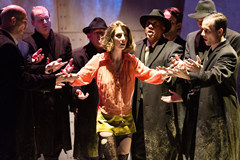| Opera Reviews | 28 April 2024 |
A troubling and engrossing world premiereby Steve Cohen |
|
Mazzoli: Breaking the Waves |
|
|
It was pleasantly surprising, therefore, to hear that her compelling score for the world premiere of Breaking the Waves is grounded in operatic tradition. Its brooding male choral writing is comparable to Benjamin Britten at the top of his game, and the instrumentation has the aura of Leoš Janácek with the discrete added spice of electric guitar. The orchestral writing of the 35-year-old Mazzoli was hypnotic while the rhythms were pulsating and propulsive. Moreover, the rich instrumental sound never covered the singers, who all could be clearly heard. Melodies were ethereal and haunting rather than shockingly dissonant. Mazzoli’s score is much easier to grasp on first hearing than the atonal 20th-century masterpieces of Alban Berg, yet the libretto by Royce Vavrek, based on the film of the same name by Lars von Trier, has a striking similarity to Berg’s Lulu. That title character, you will recall, descends to a life of sexual promiscuity and ends up being murdered by Jack the Ripper. Breaking the Waves tells the story of a respectful young woman named Bess McNeil (Kiera Duffy) in a repressed religious community in the rural highlands of Scotland, who falls in love with Danish oil-rig worker Jan (John Moore). They marry, despite the warning of black-hat church elders that relationships with outsiders are dangerous. Some mysterious aspects of this slender young waif gradually emerge. Although Bess is a virgin, she exhibits strong desires for exhibitionist sex with her husband, and she uses explicit sexual language. Characters reveal that she’s been hospitalized for mental illness in the past, and she’s on medication. After Jan goes away to work on the rig, they engage in phone sex. She begs him to come back to her quickly and prays to God that he do so. An accident on the rig leaves Jan paralyzed and impotent. Bess is racked with guilt, believing that her prayers — or his haste to return at her urging — may have led to the accident. Jan instructs Bess to find a man and have sex with him and then describe the details to him. This, he says, will keep him alive. In presenting this salacious subject matter, the opera requires Bess to appear fully naked briefly and bare-breasted for longer periods. Jan also reveals full frontal nudity, and intercourse is simulated. Yet the story is more focused on religion than it is on sex. The plot is driven by the rigidity of the churchmen and their insistence that women must do exactly what their husbands tell them to do. Bess has conversations with God and we hear her sing both sides of those conversations. She continually states her desire to be “good” and to obey God and her husband. Presumably because of her feelings of guilt and shame, Bess proceeds to promiscuity with low-life pickups, and to masochism. We begin to wonder if it was her own hidden wish to do that, rather than Jan’s expressed desire. How much of what he said was only in her head? After all, we’ve heard her relate both sides of her talks, or her hallucinations, with God. This ambivalence creates an engrossing drama. At the end of it, Bess is slashed to death and Jan miraculously recovers from his paralysis. Duffy gave a beguiling performance, portraying Bess with a transfixed innocence. She has a lovely lyric soprano voice, silvery and pure. One could imagine her someday taking the role of Liu in Puccini’s Turandot, which Opera Philadelphia is concurrently producing. Moore was a Jan with a solid baritone voice and imposing presence. Veteran opera stars Patricia Schuman and Eve Gigliotti provided rich support as Bess’s mother and sister-in-law. Zachary James made a strong impression as Jan’s best friend Terry. The dozen men of the chorus were superb as they switched between being church elders with Scottish dialect to oil rig workers with Danish. Conductor Steven Osgood produced sonorous texture from a 15-piece orchestra augmented by the sounds of electric bass, guitar, piano and organ that were pre-recorded by Mazzoli and two other instrumentalists. Prominent in the pit were a string quartet, while flute and clarinet frequently took the lead, with bold interjections by low brass, keyboards and percussion. Dramatic effects were provided when the violinist played very high notes close to the bridge of the fiddle, with extra firm bow pressure, to create scratchy or screaming sounds. James Darrah’s staging was best in its confrontational scenes with church elders and the menacing entrances of sexual predators. It seemed timid when the libretto called for sadism and bloodshed, however, which was surprising compared to the blatant display of nudity and language. Adam Rigg’s excellent scenic design used projections and slanted platforms which simulated the Scottish highlands.
|
|
| Text ©
Steve Cohen Photo © Dominic M. Mercier for Opera Philadelphia |

 The composer Missy Mazzoli is a leader of the downtown New York alt-culture, electronic rock-influenced scene. The Los Angeles Times called her music “subversive”.
The composer Missy Mazzoli is a leader of the downtown New York alt-culture, electronic rock-influenced scene. The Los Angeles Times called her music “subversive”.





